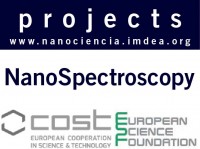NanoSpectroscopy
Prof. Johannes Gierschner & Dr. Cristina Flors
-
Funding : European Science Foundation. MPNS COST Action MP1302
-
Duration: 2013 - 2017
-
60 months
With today’s research and industry aiming for ever smaller objects and feature sizes, there is an increasing demand for spectroscopic methods to investigate processes, objects, and material properties with unprecedented spatial and temporal resolution as well as chemical
specificity. The new insights are important for issues such as understanding life on the (sub-)cellular level, light-matter-interaction, light-to-energy conversion, or materials engineering. The interdisciplinary approach of nanospectroscopy encompasses the fields of Physics, (Bio-)Chemistry, Biology, Medicine, Nanotechnology, and Materials Science. Optical nanospectroscopy uses methods such as confocal and/or ultrafast Raman and fluorescence spectroscopy for the detection and spectral analysis of objects at the nanoscale, down to the single-molecule level. In this Action, nanospectroscopic techniques will be applied to tailored materials and nanostructures (organic/inorganic, semiconducting, metallic, hybrid, bio) to gain deeper understanding of nanoscale processes. COST NanoSpectroscopy aims at consolidating European expertise on all aspects of UV/Vis/NIR nanospectroscopy (modelling, experiment, nanostructures, materials, equipment, applications) into one coherent Action. The COST networking approach is particularly well suited for this purpose. A training program will be established to spread the knowhow of applying nanospectroscopic techniques and the gained insights. In dialogue
with European industry, nanospectroscopic techniques will be further developed, e.g. as applied techniques for non-specialists.





